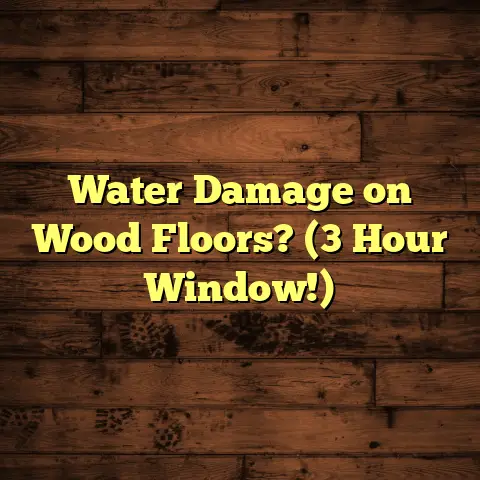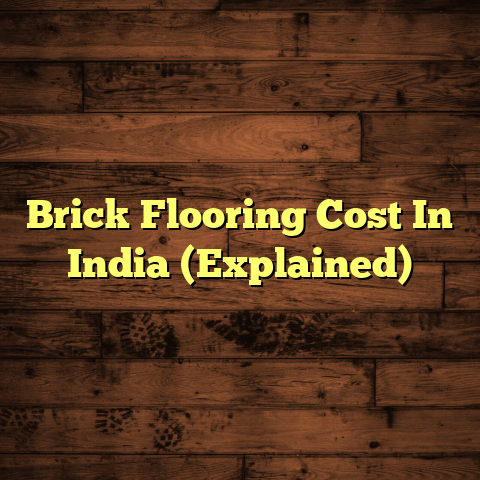Cost to Refinish Hardwood Floors in Antigua
Refinishing hardwood floors is a popular choice for homeowners who want to enhance the beauty of their existing flooring without the expense of full replacement. In Antigua and Barbuda, where hardwood is prevalent due to the abundance of tropical hardwoods, understanding the cost implications and factors involved in refinishing is essential for making informed decisions.
This comprehensive guide will cover everything from cost factors, detailed breakdowns, comparisons with alternative flooring options, to maintenance tips. With this information, homeowners can confidently navigate their refinishing projects.
Overview of Major Cost Factors
Several key factors influence the cost of refinishing hardwood floors in Antigua and Barbuda:
1. Area Size
The size of the area being refinished directly affects the total cost. Larger spaces require more materials and labor, leading to higher expenses. Costs are typically calculated per square foot. For example, refinishing a small room may cost significantly less than a large open-plan space.
Calculating Area Size
To estimate the area of your flooring, measure the length and width of the room in feet and multiply these numbers: Area=Length×Width\text{Area} = \text{Length} \times \text{Width}
For irregularly shaped rooms, break them down into smaller rectangles or squares, calculate each area individually, and sum them up.
2. Hardwood Type
Different types of hardwood have varying costs associated with them. Common woods like oak or maple may be less expensive than exotic options like teak or mahogany. The choice of wood not only influences the price but also impacts the overall aesthetics and durability of the flooring.
Popular Hardwoods in Antigua and Barbuda
- Mahogany: Highly valued for its rich color and grain, mahogany is often used in high-end homes.
- Teak: Known for its durability and natural resistance to water, making it suitable for humid environments.
- Oak: A popular choice due to its availability and versatility.
3. Labor Costs
Labor costs can vary significantly based on the contractor’s experience and reputation. Generally, hiring a professional will ensure a quality finish but may increase overall costs. In Antigua and Barbuda, skilled labor can be somewhat limited, which may drive prices higher.
4. Additional Considerations
Additional factors include:
- Floor Removal: If existing flooring needs to be removed, this adds to the labor and disposal costs.
- Subfloor Replacement: Damaged subfloors must be repaired or replaced, which can affect costs.
- Material Grade: Higher-grade materials often come at a premium.
- Room Size/Layout: Complex layouts can require more labor.
- Installation Type: Different methods (e.g., nail-down vs. glue-down) affect labor costs.
Detailed Cost Breakdown
Here’s a breakdown of costs associated with refinishing hardwood floors in Antigua and Barbuda.
Cost Per Square Foot
The average cost for refinishing hardwood floors ranges from $3 to $8 per square foot, depending on factors such as wood type and condition.
- Labor Costs: $2 to $5 per square foot
- Materials (stain, finish): $1 to $3 per square foot
Project Size Estimates
| Project Size (sq ft) | Estimated Total Cost (Low End) | Estimated Total Cost (High End) |
|---|---|---|
| 100 | $300 | $800 |
| 500 | $1,500 | $4,000 |
| 1,000 | $3,000 | $8,000 |
| 2,000 | $6,000 | $16,000 |
Example Cost Scenarios
Refinishing a Small Room (100 sq ft)
For a small bedroom (100 sq ft), assuming an average cost of $5 per square foot:
- Labor: $300
- Materials: $200
- Total Cost: Approximately $500
Refinishing a Living Room (500 sq ft)
For a larger living room (500 sq ft), assuming an average cost of $4 per square foot:
- Labor: $1,200
- Materials: $800
- Total Cost: Approximately $2,000
Refinishing an Entire Home (2,000 sq ft)
For an entire home (2,000 sq ft), assuming an average cost of $6 per square foot:
- Labor: $6,000
- Materials: $4,000
- Total Cost: Approximately $10,000
Comparison with Alternative Flooring Options
When considering flooring options, it’s essential to weigh the costs of hardwood against alternatives like laminate, vinyl, and carpet.
Laminate Flooring
- Cost: $1 to $3 per square foot
- Pros: Cheaper than hardwood, easy to install, available in various designs mimicking wood.
- Cons: Less durable and less aesthetic appeal compared to hardwood; cannot be refinished.
Vinyl Flooring
- Cost: $2 to $5 per square foot
- Pros: Water-resistant, available in various designs; suitable for kitchens and bathrooms.
- Cons: Less longevity than hardwood; can look artificial compared to real wood.
Carpet
- Cost: $2 to $7 per square foot
- Pros: Comfortable and warm underfoot; good insulation properties.
- Cons: Can stain easily; requires regular cleaning; less durable than hardwood.
Summary of Costs
| Flooring Type | Cost Per Square Foot (Low End) | Cost Per Square Foot (High End) |
|---|---|---|
| Hardwood | $3 | $8 |
| Laminate | $1 | $3 |
| Vinyl | $2 | $5 |
| Carpet | $2 | $7 |
While hardwood has a higher upfront cost than alternatives, its durability and aesthetic appeal often justify the investment.
Signs That Hardwood Floors Need Replacement
Before proceeding with refinishing, it’s crucial to identify whether your hardwood floors need replacing:
1. Deep Scratches or Gouges
If the damage is extensive and cannot be sanded out effectively, it may be time for replacement. Minor scratches can usually be fixed with refinishing but deeper damage requires more drastic measures.
2. Severe Cupping or Crowning
Severe cupping (where the edges of the boards are higher than the center) or crowning (where the center is higher) indicates moisture issues that may compromise structural integrity. If these conditions are present across large areas of flooring, replacement may be necessary.
3. Rot or Mold
Signs of decay suggest that replacement is necessary. Mold growth between boards or underneath flooring can indicate moisture intrusion that could damage the entire structure.
4. Board Separation
If you notice gaps between your floorboards that are wider than a credit card, it may indicate that your flooring has not been properly maintained or is severely damaged.
Pros and Cons of Hardwood Flooring
Understanding the advantages and disadvantages of hardwood flooring can help homeowners make informed choices.
Pros
- Aesthetic Appeal: Hardwood floors provide a timeless look that enhances the beauty of any space.
- Durability: With proper care, hardwood floors can last for decades or even centuries.
- Increases Home Value: Quality hardwood flooring can significantly enhance property resale value.
- Variety of Choices: Available in a wide range of species, colors, and finishes.
Cons
- Cost: Higher initial investment compared to other flooring types.
- Maintenance: Requires regular upkeep to maintain its appearance; susceptible to scratches and dents.
- Susceptibility to Water Damage: Needs protection from moisture; improper installation can lead to issues like warping.
- Noise: Can be noisy underfoot compared to carpet.
Cost Differences Between Professional Installation and DIY
One of the most significant decisions homeowners face is whether to hire professionals for refinishing or tackle the project themselves.
Professional Installation
Hiring a professional can range from $2 to $5 per square foot for labor. Professionals bring expertise that impacts the quality of the finish and can save time. They also have access to specialized equipment that may not be available for rent or purchase by DIYers.
Benefits of Professional Installation
- Expertise ensures high-quality results.
- Appropriate equipment (e.g., floor sanders) leads to more efficient work.
- Insurance protects against potential damage during refinishing.
DIY Installation
While DIY may save on labor costs, it requires:
- Tools: Renting or purchasing tools like sanders, buffers, and vacuums (Initial investment can range from $200 to $1,000).
- Skills: Knowledge of finishing techniques is important for achieving desired results.
Considerations for DIY
- Time Commitment: DIY projects may take longer than anticipated; consider your availability.
- Skill Level: Assess whether you have the necessary skills; mistakes can lead to costly repairs.
- Safety Equipment: Proper safety gear is essential when working with chemicals or heavy machinery.
Conclusion on Installation Choices
For those with experience and confidence in their abilities, DIY can be a cost-effective solution. However, for best results and peace of mind, professional installation is often recommended.
Questions to Ask Hardwood Flooring Contractors
When selecting a contractor for refinishing, consider asking:
- What is your experience with hardwood refinishing?
- Can you provide references or examples of previous work?
- What methods do you use for sanding and finishing?
- Are you licensed and insured?
- How will you protect my home during the process?
- What type of finishes do you recommend for my specific wood?
- How long will the project take?
- Are there any additional costs I should anticipate beyond your estimate?
Hardwood Floor Care and Maintenance Tips
To maximize the longevity of your hardwood floors:
1. Regular Cleaning
Use a soft broom or vacuum regularly to remove dirt and debris that can scratch the surface. Avoid using vacuums with beater bars as they can damage the wood.
2. Avoid Excess Water
Wipe spills immediately; avoid mopping with water as it can seep into seams and cause warping over time. Use specialized wood floor cleaners instead.
3. Use Floor Protectors
Place felt pads under furniture legs to prevent scratches when moving items around your home.
4. Reapply Finish as Needed
Depending on wear and tear from traffic patterns in your home, consider reapplying finish every few years instead of opting for full refinishing again.
5. Control Humidity Levels
Maintain indoor humidity levels between 30% and 50% year-round using humidifiers or dehumidifiers as needed; excessive moisture can lead to expansion while dry conditions can cause contraction.
Conclusion
Refinishing hardwood floors in Antigua and Barbuda can be a worthwhile investment that enhances the beauty and value of your home. By considering the various costs and factors outlined in this guide, homeowners can make informed decisions that suit their budget and needs. Whether opting for professional services or taking on a DIY project, understanding the nuances of hardwood flooring will lead to successful outcomes.
Final Thoughts on Refinishing Hardwood Floors
Refinishing hardwood floors not only rejuvenates your living space but also prolongs the life of your flooring investment. With careful planning and consideration of costs involved—ranging from materials to labor—and by maintaining proper care practices post-refinishing, you can enjoy stunning hardwood floors for many years to come.
In summary:
- Assess your current flooring condition thoroughly before deciding on refinishing versus replacement.
- Plan your budget carefully by considering all associated costs.
- Choose high-quality materials and experienced contractors when possible.
- Maintain your floors diligently after refinishing to ensure they remain beautiful over time.
By following these guidelines and utilizing this comprehensive resource as a reference point during your project planning phase, you’re setting yourself up for success in achieving beautiful hardwood floors that enhance your home’s appeal.





